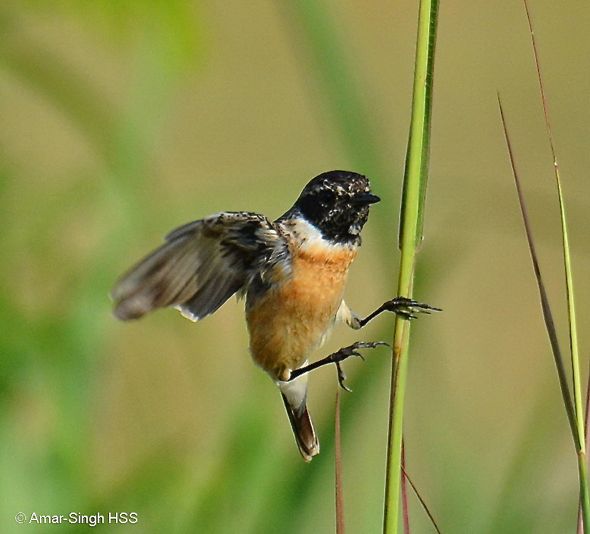“The Eastern Stonechat (Saxicola maurus) is a common migrant in the north but in Peninsula Malaysia is an ‘uncommon and localised’ migrant. I am indebted to Jing-Yi Tou, a bird watching colleague, who spotted this bird, just before Christmas 2013, in an open area with tall grass in the city.
“This location was a ‘happy hunting ground’ for both of us to watch birds that use the open grassland habitat but is now being extensively developed. I had made 4-5 trips there to find the bird but failed, as the location is large. Today when my wife and I were cycling by we spotted it by the roadside. It is already assuming breeding plumage. The bird has a frequent habit of flicking the tail and will often descend to the ground to feed.
“My wife (Swee-Im, Lim) was confident she saw two different birds. I doubted her until I returned to process images and noticed that one male has a much lighter belly, seen in all images and taken at the same time in same lighting. So two males sharing the habitat. (bottom).
“Urquhart, E. (2002; Stonechats: A Guide to the Genus ‘Saxicola’. London: Christopher Helm) states ‘In Malaysia and Borneo it occurs in buffalo pasture, paddyfields and marshes in the lowlands throughout the winter.’ The habitat this bird spent the winter in is an urban area with lots of housing and shops surrounding the fields.
“Wells, D.R. (2007; The birds of the Thai-Malay Peninsula: Vol. 2 Passarines. Christopher Helm, London) states that the only subspecies identified in the peninsula is stejnegeri.”
Jing-Yi Tou, Dato’ Dr Amar-Singh HSS & Datin Dr Swee-Im Lim
Ipoh, Perak, Malaysia
23rd February 2013
Location: Ipoh City, Perak, Malaysia
Habitat: Open land, mainly tall grass with some secondary growth, construction













One Response
Interestingly, a third individual, a female was also found in the same vicinity, giving a total count of at least 3 birds in the vicinity. Sadly, they were not seen in the next season and more and more parts of this fragile habitat is now fenced up for more developments.